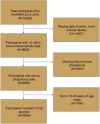Association between serum phosphorus levels and pelvic bone mineral density in U.S. adults aged 18-59 years
- PMID: 40624495
- PMCID: PMC12236046
- DOI: 10.1186/s12891-025-08838-y
Association between serum phosphorus levels and pelvic bone mineral density in U.S. adults aged 18-59 years
Abstract
Background: Although the role of serum phosphorus in bone metabolism is well-established, its precise connection to bone density in different anatomical regions remains uncertain. The pelvis, a vital load-bearing structure crucial for movement and stability, has received limited attention because of its relationship with serum phosphorus. This study investigated the potential association between serum phosphorus levels and pelvic bone mineral density (BMD) in adults aged 18 to 59 years.
Methods: Using data from the 2015-2018 National Health and Nutrition Examination Surveys NHANES, we applied multivariable logistic regression models to investigate the association between serum phosphorus levels and pelvic BMD. The analysis was further refined using smoothed curves and generalized additive models.
Results: The analysis included a total of 5,589 adults. After adjusting for confounding variables, a negative association was observed between serum phosphorus levels and pelvic BMD. This inverse association was consistent in the subgroup analyses for females and Whites, however, this correlation was not found in males, Blacks, Mexican Americans, other Hispanics, or other racial groups.
Conclusion: Our findings indicated a notable inverse association between serum phosphorus levels and pelvic bone mineral density in females, while no significant association was observed in males.
Keywords: National health and nutrition examination surveys; Pelvic bone mineral density; Serum phosphorus levels.
© 2025. The Author(s).
Conflict of interest statement
Declarations. Ethic approval and consent to participate: The NHANES protocols were approved by the Ethics Review Board of Third Affiliated Hospital of Naval Medical University, and written informed consent was obtained. Additionally, the study, in accordance with the Declaration of Helsinki, protocols received approval from the Third Affiliated Hospital of Naval Medical University’s research ethics committee at the Naval Medical University in Shanghai, China. Consent for publication: N/A. Competing interests: The authors declare no competing interests. Clinical trial number: Not applicable.
Figures




Similar articles
-
Effectiveness and safety of vitamin D in relation to bone health.Evid Rep Technol Assess (Full Rep). 2007 Aug;(158):1-235. Evid Rep Technol Assess (Full Rep). 2007. PMID: 18088161 Free PMC article.
-
Associations between systemic inflammation response index and femur bone mineral density in adults: The NHANES 2005-2010, 2013-2014, and 2017-2018.Medicine (Baltimore). 2025 Feb 21;104(8):e41565. doi: 10.1097/MD.0000000000041565. Medicine (Baltimore). 2025. PMID: 39993115 Free PMC article.
-
The association between body roundness index and risk of osteoporosis in patients with type 2 diabetes mellitus: A cross-sectional study based on NHANES database.J Orthop Surg (Hong Kong). 2025 May-Aug;33(2):10225536251356804. doi: 10.1177/10225536251356804. Epub 2025 Jul 1. J Orthop Surg (Hong Kong). 2025. PMID: 40591954
-
Association between hand grip strength and bone mineral density in US adolescents aged 12-19 years: a cross-sectional study.Eur J Pediatr. 2025 Jul 16;184(8):487. doi: 10.1007/s00431-025-06309-z. Eur J Pediatr. 2025. PMID: 40670852 Free PMC article.
-
Calcium and vitamin D for increasing bone mineral density in premenopausal women.Cochrane Database Syst Rev. 2023 Jan 27;1(1):CD012664. doi: 10.1002/14651858.CD012664.pub2. Cochrane Database Syst Rev. 2023. PMID: 36705288 Free PMC article.
References
-
- Wang Y, Li D, Lv Z, Feng B, Li T, Weng X. Efficacy and safety of Gutong patch compared with NSAIDs for knee osteoarthritis: A real-world multicenter, prospective cohort study in China. Pharmacol Res. 2023;197:106954. - PubMed
-
- Basile G, Passeri A, Bove F, Accetta R, Gaudio RM, Calori GM. Pelvic ring and acetabular fracture: concepts of traumatological forensic interest. Injury. 2022;53(2):475–80. - PubMed
MeSH terms
Substances
LinkOut - more resources
Full Text Sources
Medical

